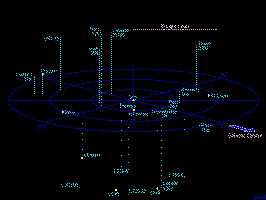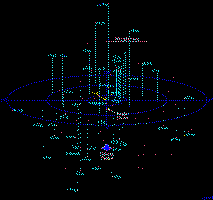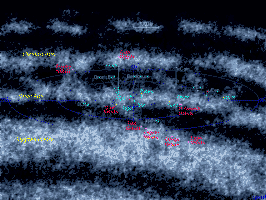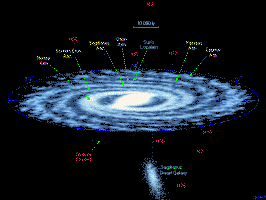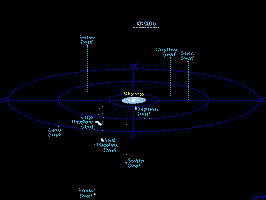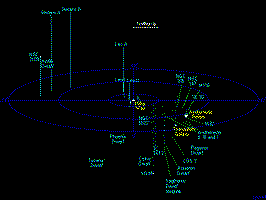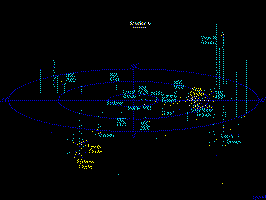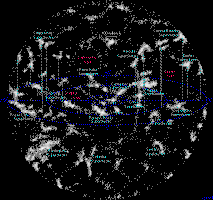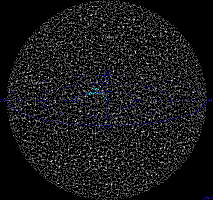|
08 -
Large-scale Disagreements
According to Krapf, less than two years later in 1997 he was unexpectedly taken up for a three day visit on a large, disk-shaped craft owned by "Verdants" - thin, slightly bulge-eyed aliens with large heads; roughly 5' 6" inches tall. Krapf says the Verdants’ skin is either white or tan with greenish tints. He says they have slightly peaked ear tips and dark eyes that look out from slanted openings that aren’t much more than slits.
An earnest, well-regarded journalist who speaks with no outward sign of dishonesty, Krapf suggests that he may have been selected for the encounter because he's a respected professional who was previously skeptical about aliens and UFO's.
Krapf won a
Pulitzer Prize as an editor of one of the best newspapers in the
country. He did fact checking and was responsible for steering
reporters and removing inaccuracies in their stories. Given his
conservative, mainstream stature, he’s one of the most well regarded
witnesses to aliens.
Krapf was told that Verdants are from a galaxy that’s 14 million light years away.
Krapf was told their original home planet is 2½ times the size of Earth and was named Verdant for the lushness of its plant life. Krapf’s writing is internally consistent and includes specifics that seem beyond the imagination of a man like Krapf. Overall, his account matches reports by hundreds of people who claim to have encountered gray aliens.
See the writings of Dr. John Mack, Budd Hopkins and David Jacobs PhD for further details.
Dan Sheehan, the lawyer who argued the Pentagon Papers case for the New York Times and the Silkwood case, writes,
If true, Krapf's story would be the second full-length, minute-by-minute account about an open alien attempt at diplomatic interaction with fully conscious humans.
The first was Alec Newald’s book, Coevolution, about a ten-day journey to Haven, the planet of a competing alien group. There have been other books about alien contacts that some readers might consider diplomatic, yet they were neither as prolonged and explicit nor as recent as Krapf’s and Newald’s books, in which aliens appear to have gone out of their way to accommodate the writers by providing psychotronically effected, near-total recall.
Apparently, that was done to facilitate publication of both stories. Given the frequency of recent contacts and sightings plus a cryptic dribble of human officials’ disclosures, those three books stand out in a fast-developing, new context.
Krapf writes that he was taken for a second visit with
Verdants three years later in 2000.
Krapf notes that Verdants are slim after living on other planets, but they still have quick nerve impulses. Krapf writes that Verdants are capable of quick, almost cat-like movements, as are most aliens we read about.
More importantly, Verdants and other aliens do fast, nearly instantaneous shifts of thought that are typical of negative and alternate cycle energy.
* Watch how small birds move and study their
impulses - that’s more akin to how alien mind impulses shift quickly
yet subtly.
Alien minds course more deeply inward (in a physics sense), while also expanding far outward, often beyond their bodies. Their psychotronic technology does fast-burst, nearly instantaneous communication in finely networked ways that allow for varied mood and disposition. To a human initiate, alien thought seems to flow at great speed in fine detail, which is due to the greater, more condensed nature of gravitic resonance.
Humans are
capable of similar mind resonance. All you have to do is divide your
awareness (fractional integration in a larger context), rather than
pretend to multiply it. As far as we know, aliens don’t drink
alcohol because it kills brain cells and reduces memory.
So, we shouldn't conclude that Verdant numbers mean they control a number of large galaxies.
A
single large spiral galaxy could contain most of the Verdant
alignment. For example, if all Verdant planets were in a single
large spiral galaxy like the Milky Way, Verdants would live in but
one of every 600,000 to 1,000,000 star systems.
So, if Krapf is correct we live within reach of a galaxy that’s 14 million light years away and inhabited by colonizing Verdants who speak in terms of a federated structure, which implies a central, over-riding authority.
Verdant and gray alien abductions of humans may have accelerated our awareness of off-world dynamics.
Krapf writes that in a series of meetings on a 1½ mile diameter, disk-shaped craft with many windows and entry ports, Verdants admitted that they orchestrated years of human abductions for scientific and breeding purposes prior to attempting a diplomatic opening to humankind. Gravitics were apparently used to slow certain brain processes and render abductees semi-conscious so that they wouldn’t remember such events.
Krapf’s story is the first
that presents an integrated overview of such abductions. It may be
important. Navy intelligence briefer to the Pacific Fleet Commander,
William Cooper, corroborated Krapf’s report about a large alien
mother ship that hovers in the far side shadow of the moon. (Cooper,
“Operation Majority”)
While in the disk, Krapf learned that a Times Mirror executive (LA Times) was part of the program. Later, Krapf spoke with the man, who fearfully admitted involvement. Krapf saw a list and photos of hundreds of other human contacts for the Verdant diplomatic initiative. For yet-unspecified reasons, the Verdant opening was delayed several years past its planned date.
Krapf says the Verdants
he met seemed reticent yet certain that Verdants would succeed in
setting the agenda here, which seems ironic because Verdants
proposed that they be allotted 600 square miles of empty land in the
US Southwest to build a center for interaction with humans.
It may have stalled because Verdants have little
chance here, yet due to bureaucratic inertia and breeding program
infiltration of human sectors, they must go through the motions of
an opening, if not some bitter, last-minute attempts to coax us
toward such ends. Apparently, further delays diminish Verdant
chances here because humans become more informed and technologically
capable with time.
Such humans may
have genetic and other IFSP contributions that go unnoticed. The
alien source for this report, and his colleagues, have provided
breakthrough information at various junctures. Leery of damages done
by IFSP manipulators, they seem to want to help humans.
Based on a new kind of remote sensing, such methods can be practiced by most humans. First, you must practice remote sensing, which uses human nerve resonance to feel around sites or events that involve IFSP aliens and look for their signature kind of energy streaming. Such energy streams stand out starkly, compared to the background, and usually instantly trace back to an IFSP technology site. What makes that easy is the fact that different kinds of electrogravity used by different populations have different energy signatures (especially the psychotronic component).
Because such energy streams are full of detailed information content, sorting them out is easy and intuitive, once a person has learned to:
Although a less common option, the latter method is quite effective.
Almost anyone can do it - with practice. Advanced remote sensing can
even detect past IFSP interactions with a “direct operative” in
question. This is possible because electrogravity and negative
energy resonate both outwardly and inwardly more extensively than is
immediately apparent.
* Author’s note: no direct harm is intended to any
individual, and readers should know that those who sympathize with
or are simply entranced by new alien encounters aren’t considered
“direct operatives.” Direct operatives would have no qualms about
harming this planet and its inhabitants in order to serve the IFSP
agenda, while a mere aficionado would recoil at the thought. (Krapf
isn’t a direct operative.) It’s a tricky situation because Verdant
resources would have allowed them to give material and other
advantages to their direct operatives over many years time. Given
the Verdant record elsewhere, Verdant designs on our energy and
other resources could be cause for concern.
Please remember, that’s first-hand reporting by a
clear-headed, Pulitzer-winning journalist. His report is partly
corroborated by hundreds of others, including military brass who
served in the White House.
Ambassadors are humans reportedly taken to the Verdant ship to be indoctrinated and then used in a Verdant plan to absorb Earth into the IFSP. (The Challenge of Contact, p. 13)
The
matter is mentioned here because it relates to Verdant thought and
behavior in our vicinity. Given the diversity and independence of
human societies, Verdant prospects here would seem dim. If such is
the case, then Earth would be a foreign policy failure. Bad feelings
and resentful, last-minute gestures could be expected. Expansionist
designs of the sort seldom end pleasantly.
Army Col. Phillip Corso, a staff member of Eisenhower’s National Security Council who also worked in the Pentagon, wrote the most famous commentary. In his 1998 book, The Day After Roswell, Corso claimed that he worked on a Pentagon project to distribute and reverse-engineer technology gathered from the alien craft that crashed near Roswell, NM in 1947.
Corso's book was the first full-length, high-level disclosure of the sort.
Senator John Stennis wrote a glowingly favorable preface for the book but then tried to retract it later.
Writing with co-author and UFO magazine publisher
William Birnes, PhD, Corso suggested that beginning with Harry
Truman and climaxing with
the Eisenhower
administration, US defense
and intelligence officials privy to an alien crash at Roswell began
to fear that grays and affiliated aliens posed a threat. Part of the
fear is attributed to military frustration at being unable to either
explain or compete with such aliens.
Decades later,
however, there’s evidence that grays are sentient beings capable of
very human-like error.
The Virgo supercluster contains some 2000 galaxies. In short, Verdants would represent but one galaxy out of a vastly larger 50 billion to 100 billion galaxies in the visible universe. Some of the Verdants’ alien competitors go out of their way to emphasize this fact with specific reference to Verdants, by the way. Other reports partly corroborate Krapf's story about Verdants.
For example, hundreds, if
not thousands of witnesses say they’ve encountered gray aliens who
work on a breeding program, which is further evidence of a
Verdant-IFSP presence in our system. Because independent abductee
and contactee reports from all over the globe often agree on precise
details, we should give Krapf's reports their due consideration.
Disputes arise because, like many humans, I'm actively critical of Verdant-gray intentions. Prior to reading Krapf's book I had no clearly defined context in which to identify Verdants (who were extant at the time) because Verdants normally try to obscure themselves behind lesser, dependent aliens of their group, i.e. grays and gray-human hybrids. It’s a matter of pride and official priority that they do so.
After
Krapf’s book
was published, specific details
about some of my own, ongoing interactions were brought into sharp
focus. Although I disagree with aspects of Krapf's story, i.e.
Verdant remarks about an "angelic" intermediary for some of their
contacts with humans (a sop that smacks of Verdant propaganda), it
is earnest and informative.
Verdants
are cited for provoking militarization and the infiltrated sabotage
of other worlds’ ecologies.
In a larger context, there are much greater considerations.
Some readers may
disagree with the assertion, yet it's based on reports by black
budget whistle-blowers, abductees and other contactees, plus aliens
who can easily be identified. There's an urgent tone in such
messages. In a larger sense, one can imagine an alien in a
neighboring galaxy supercluster reading about the situation here,
then wincing because it reminds him/her of a similar situation
there.
For those who don't know how our local galaxy group looks, it's a great help. If you haven't already done so, please, before you read the rest of this book, link to the site, then go to the link at the bottom, where you can zoom in and out on our galaxy’s neighborhood, plus the rest of the universe. In minutes you'll get a vivid sense of where we live.
You
may begin to extrapolate the inter-galaxy politics that we’re being
introduced to. In a universe of 50-100 billion galaxies (or more),
there is much to learn.
M83 is a large spiral galaxy located in the Centaurus A galaxy group. A few alien sources have suggested that M83 is, in fact, the Verdant home galaxy.
In addition, one highly detailed map was communicated to indicate Verdant outposts in other galaxies.
In the map, communicated by an alien more evolved than Verdants who monitors the situation here closely, Verdant IFSP outposts are concentrated in the Centaurus A galaxy group, primarily centering on the galaxy M83 but fingering into other galaxies of Centaurus A.
If I’m not mistaken, Verdants are not the most numerous population in the other two large spirals of their home galaxy group. Instead, other native populations are more numerous. Verdant outposts finger lightly into the Sculptor galaxy group and slightly into our Andromeda-Milky Way group, which borders on the Virgo supercluster of galaxies.
Apparently, the
native populations of these two galaxy groups are dominant here, not Verdants. All three galaxy groups are small groups that each contain
3-6 large galaxies and a few dozen smaller irregular or elliptical
galaxies.
Rather
than assume that unoccupied territory is simply open for the taking,
humans have been advised to remember that all large galaxies are
already inhabited by advanced civilizations. In other words, the
most important task for humans, now, is to be self-sufficient and
learn about responsible alien populations, rather than stumble out
in pig-headed search of real estate.
Should we continue down our present, one-way street toward global ecological breakdown, we can expect the larger alien community to either distance itself from the regime(s) here or try to convince us to change before we become a threat to our neighbors.
People who
interact with aliens hear advisories of the sort regularly.
For example,
Aliens touch on such themes during interactions with growing numbers of humans.
Aliens further suggest that such considerations are now so obvious as to be mathematically explicit.
|
||||||||||||
